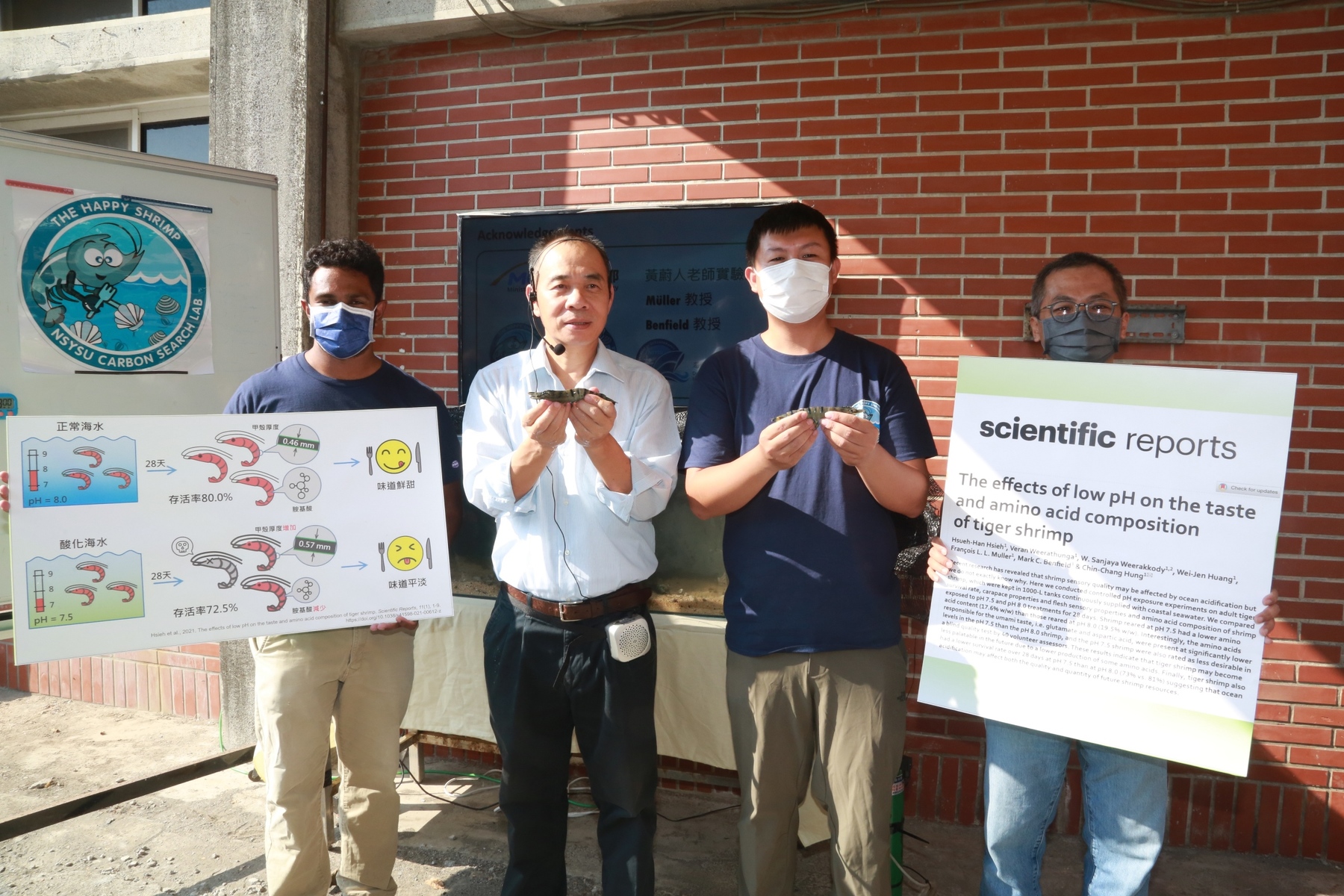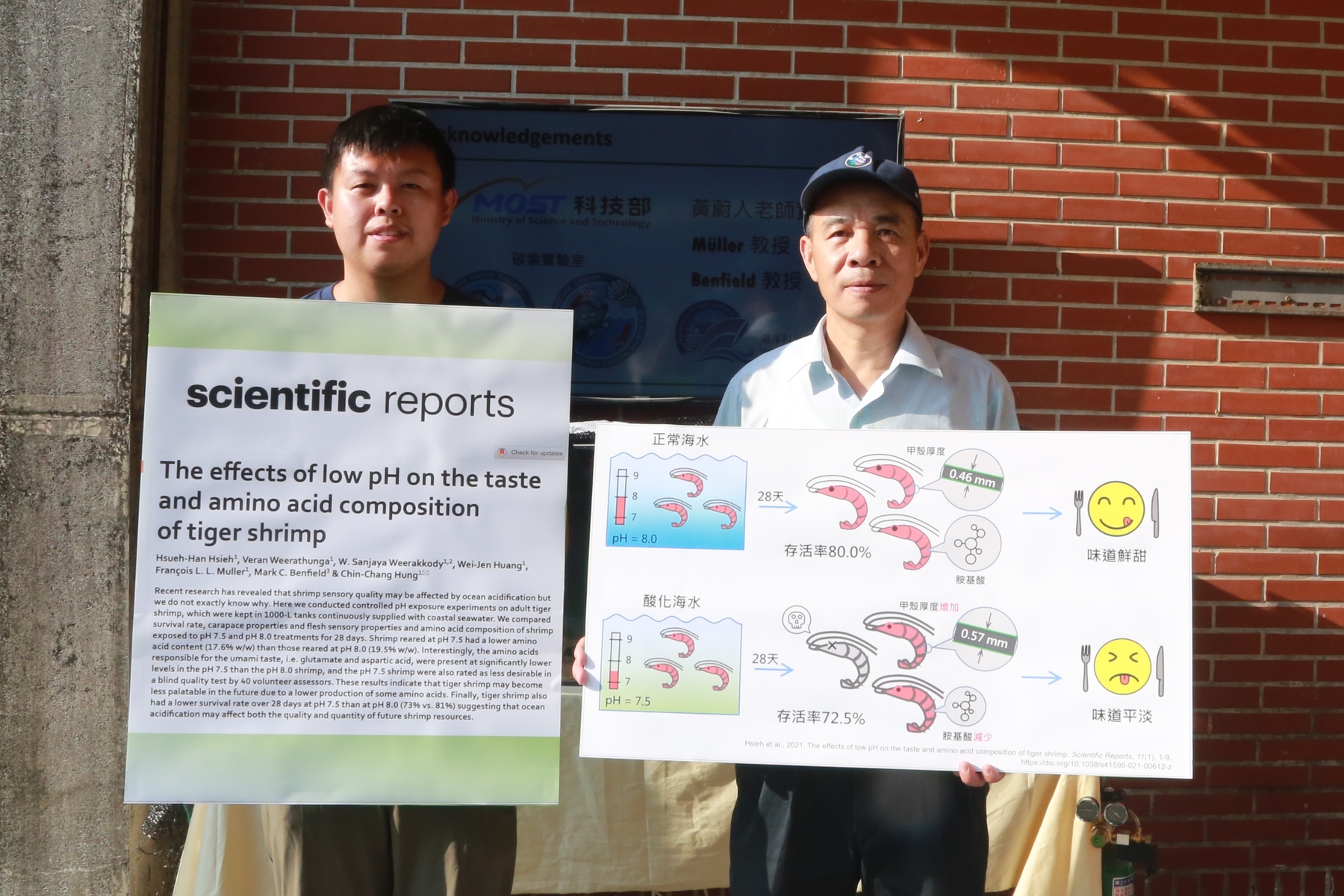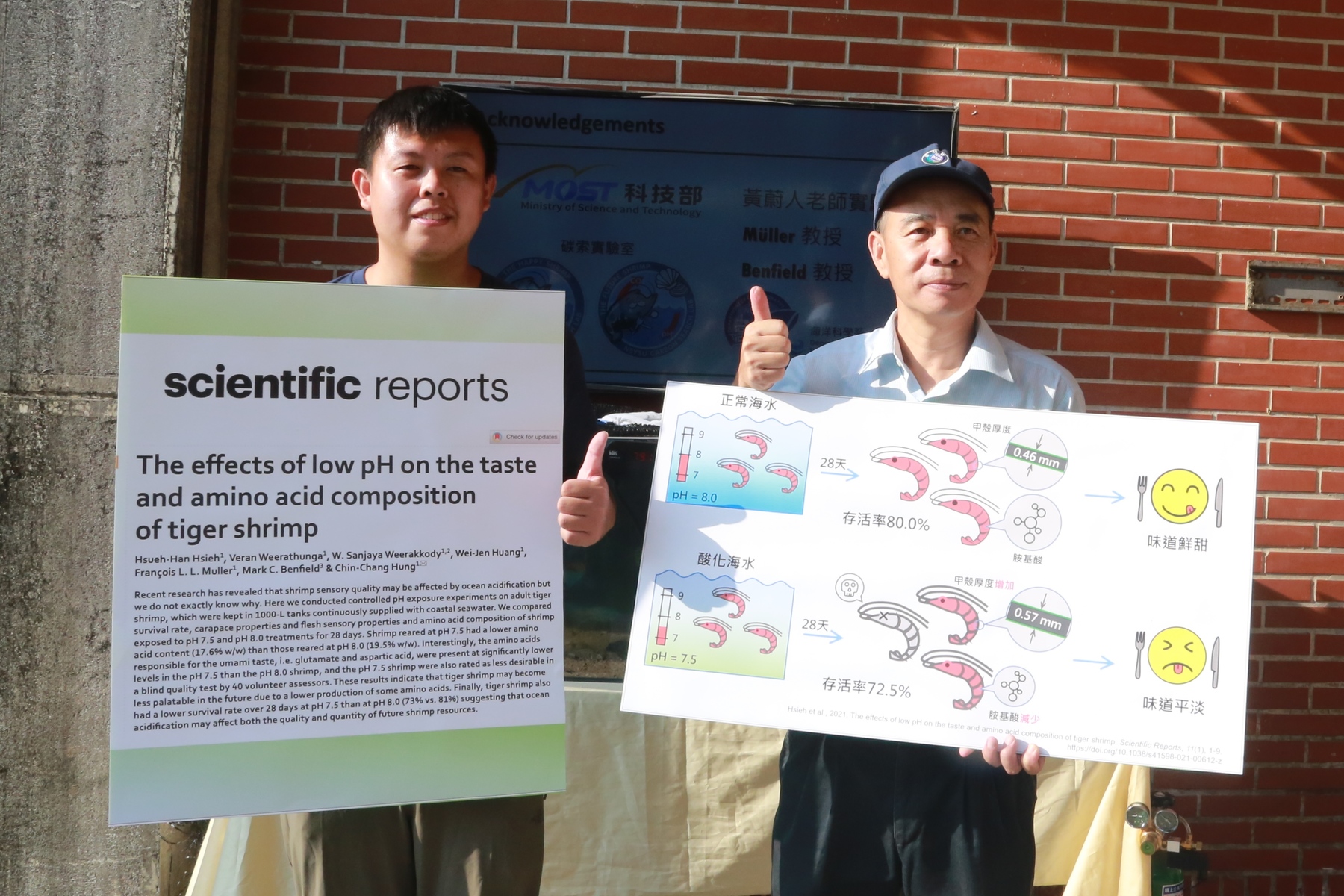Ocean acidification affects taste and amino acid composition of tiger shrimp: NSYSU’s new study in Scientific Reports




2021-11-19
As global carbon emissions increase, the concentration of carbon dioxide in the atmosphere rises, causing more carbon dioxide to dissolve in seawater, which results in ocean acidification. This further affects the nutrition and taste of tiger shrimp, one of the world's most popular seafood. The results, a blind quality test by 40 volunteer assessors, indicate that tiger shrimps that lived in seawater of lower pH for four weeks were less palatable, aromatic, and their appearance was less appealing than of those that lived in more alkaline seawater due to lower production of certain amino acids. The test was conducted by the Dean of the College of Marine Sciences Chin-Chang Hung, doctoral student Hsueh-Han Hsieh, Assistant Professor Wei-Jen Huang and Associate Professor François Lucien Leon Muller of National Sun Yat-sen University Department of Oceanography, Professor Mark Benfield of the Louisiana State University, US, and graduate students from Sri Lanka Veran Weerathunga and W. Sanjaya Weerakkody. The results of the study were published in the international journal Scientific Reports.
Professor of National Sun Yat-sen University Department of Oceanography and Dean of the College of Marine Sciences Chin-Chang Hung pointed out that according to the estimates of the Inter-Governmental Panel on Climate Change (IPCC), by the end of the 21st century, the average pH of seawater will drop by (pH=0.4), from the present-day (pH=8.1) to (pH=7.7). The warming effects and extreme weather, droughts, torrential rains, and forest fires caused by massive CO2 emissions are easily noticeable. However, ocean acidification is less directly observable by the general public. Though past studies have shown that ocean acidification poses a significant threat to corals and shellfish such as oysters and clams, only a few studies reported that ocean acidification makes shrimp taste less sweet, however, the reason for this was unclear. Shrimp is an important scavenger in the ocean, an important species harvested and farmed worldwide, and one of the world's most popular seafood worldwide.
According to the research team, tiger shrimp was one of the “stars” of Taiwan's foreign exchange earnings in the past. Larger tiger shrimp are a must-eat at wedding banquets and during Chinese New Year. With the seawater gradually becoming less alkaline, it is a question whether the tiger shrimp can survive and whether it has a better strategy to resist ocean acidification. This study examines the survival rates and how the quality and taste of tiger shrimp may change in the future with the seawater acidified. The research team grew healthy shrimps outdoors for a certain amount of time and later moved them to a controlled environment where they were kept in normal seawater (pH=8.0) and in seawater exposed to high concentrations of CO2 (simulated ocean acidification at pH=7.5) to then monitor the shrimps’ survival rate, amino acid composition, and changes in shell thickness and composition. At the end of the four-week experiment, the team invited shrimp connoisseurs to evaluate the taste of tiger shrimps grown in normal seawater and acidified seawater.
The research team found that the mortality rate of tiger shrimps in the pools simulating ocean acidification (pH=7.5) was significantly higher than that of tiger shrimps grown in normal seawater (pH=8). The shrimps grown in acidified seawater had thicker shells, and this result was also reflected in the scores given by the connoisseurs on the deliciousness of tiger shrimp raised in acidified seawater. According to the results of the blind quality test by 40 assessors, the appearance, taste, and aroma of tiger shrimps grown in acidified seawater were inferior to those of tiger shrimps grown in normal seawater. The team also analyzed the amino acid composition of tiger shrimp and confirmed that the total amino acids in tiger shrimps grown in acidified seawater were lower than those of tiger shrimps grown in normal seawater. The team also analyzed the concentration of amino acids of different flavors (sour, sweet, bitter, fresh) in shrimp grown in acidified and normal seawater, and found that the concentration of amino acids that give them a fresh taste was significantly lower in shrimps grown in acidified environment than in normal seawater.
In this study on tiger shrimp, the National Sun Yat-sen University research team found out that ocean acidification will affect the taste of seafood in the future. Also, the mortality rate of tiger shrimp will be influenced by increasing ocean acidification, resulting in decreasing populations. The research team suggested that carbon emissions should be reduced to slow down ocean acidification.
Article link: https://www.nature.com/articles/s41598-021-00612-z
As global carbon emissions increase, the concentration of carbon dioxide in the atmosphere rises, causing more carbon dioxide to dissolve in seawater, which results in ocean acidification. This further affects the nutrition and taste of tiger shrimp, one of the world's most popular seafood. The results, a blind quality test by 40 volunteer assessors, indicate that tiger shrimps that lived in seawater of lower pH for four weeks were less palatable, aromatic, and their appearance was less appealing than of those that lived in more alkaline seawater due to lower production of certain amino acids. The test was conducted by the Dean of the College of Marine Sciences Chin-Chang Hung, doctoral student Hsueh-Han Hsieh, Assistant Professor Wei-Jen Huang and Associate Professor François Lucien Leon Muller of National Sun Yat-sen University Department of Oceanography, Professor Mark Benfield of the Louisiana State University, US, and graduate students from Sri Lanka Veran Weerathunga and W. Sanjaya Weerakkody. The results of the study were published in the international journal Scientific Reports.
Professor of National Sun Yat-sen University Department of Oceanography and Dean of the College of Marine Sciences Chin-Chang Hung pointed out that according to the estimates of the Inter-Governmental Panel on Climate Change (IPCC), by the end of the 21st century, the average pH of seawater will drop by (pH=0.4), from the present-day (pH=8.1) to (pH=7.7). The warming effects and extreme weather, droughts, torrential rains, and forest fires caused by massive CO2 emissions are easily noticeable. However, ocean acidification is less directly observable by the general public. Though past studies have shown that ocean acidification poses a significant threat to corals and shellfish such as oysters and clams, only a few studies reported that ocean acidification makes shrimp taste less sweet, however, the reason for this was unclear. Shrimp is an important scavenger in the ocean, an important species harvested and farmed worldwide, and one of the world's most popular seafood worldwide.
According to the research team, tiger shrimp was one of the “stars” of Taiwan's foreign exchange earnings in the past. Larger tiger shrimp are a must-eat at wedding banquets and during Chinese New Year. With the seawater gradually becoming less alkaline, it is a question whether the tiger shrimp can survive and whether it has a better strategy to resist ocean acidification. This study examines the survival rates and how the quality and taste of tiger shrimp may change in the future with the seawater acidified. The research team grew healthy shrimps outdoors for a certain amount of time and later moved them to a controlled environment where they were kept in normal seawater (pH=8.0) and in seawater exposed to high concentrations of CO2 (simulated ocean acidification at pH=7.5) to then monitor the shrimps’ survival rate, amino acid composition, and changes in shell thickness and composition. At the end of the four-week experiment, the team invited shrimp connoisseurs to evaluate the taste of tiger shrimps grown in normal seawater and acidified seawater.
The research team found that the mortality rate of tiger shrimps in the pools simulating ocean acidification (pH=7.5) was significantly higher than that of tiger shrimps grown in normal seawater (pH=8). The shrimps grown in acidified seawater had thicker shells, and this result was also reflected in the scores given by the connoisseurs on the deliciousness of tiger shrimp raised in acidified seawater. According to the results of the blind quality test by 40 assessors, the appearance, taste, and aroma of tiger shrimps grown in acidified seawater were inferior to those of tiger shrimps grown in normal seawater. The team also analyzed the amino acid composition of tiger shrimp and confirmed that the total amino acids in tiger shrimps grown in acidified seawater were lower than those of tiger shrimps grown in normal seawater. The team also analyzed the concentration of amino acids of different flavors (sour, sweet, bitter, fresh) in shrimp grown in acidified and normal seawater, and found that the concentration of amino acids that give them a fresh taste was significantly lower in shrimps grown in acidified environment than in normal seawater.
In this study on tiger shrimp, the National Sun Yat-sen University research team found out that ocean acidification will affect the taste of seafood in the future. Also, the mortality rate of tiger shrimp will be influenced by increasing ocean acidification, resulting in decreasing populations. The research team suggested that carbon emissions should be reduced to slow down ocean acidification.
Article link: https://www.nature.com/articles/s41598-021-00612-z
Click Num:
Share
